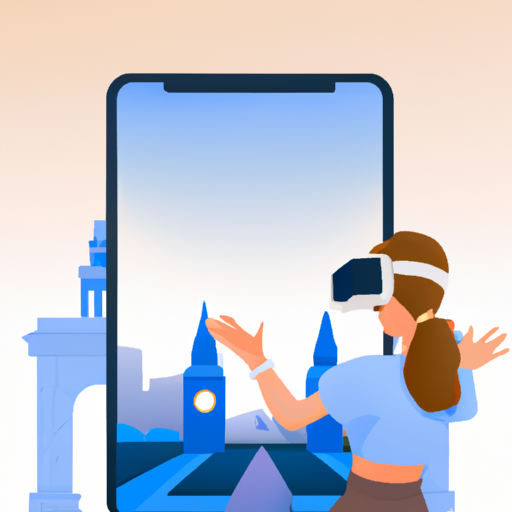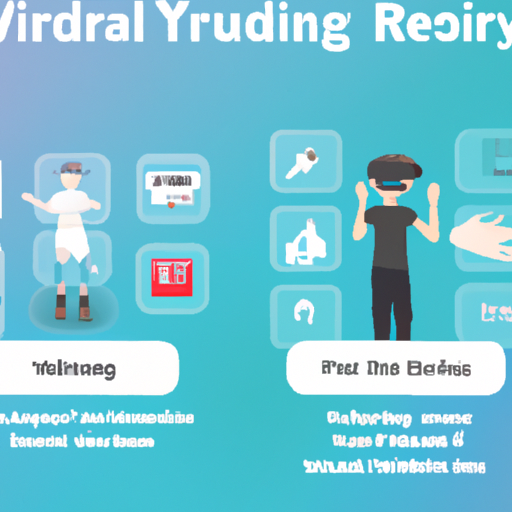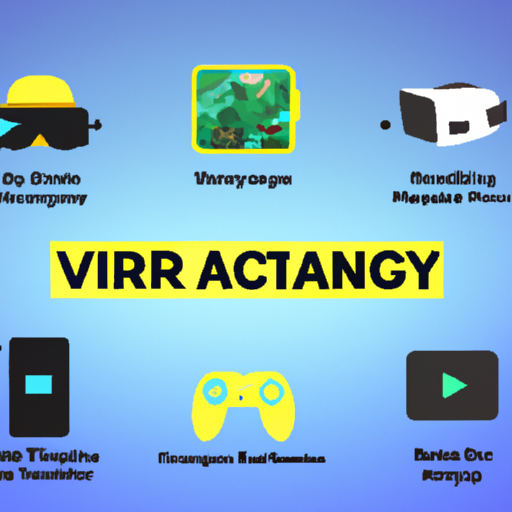-
Table of Contents
- Introduction
- The Future of VR/AR in Tourism and Travel: What to Expect
- How VR/AR is Enhancing the Travel Planning Process
- The Impact of VR/AR on Tourist Attractions and Experiences
- Exploring the Benefits of VR/AR for Tourists and Travelers
- How VR/AR is Transforming the Tourism and Travel Industry
- Conclusion
“Explore the world without leaving your home – Virtual and Augmented Reality in Tourism and Travel!”
Introduction
Virtual Reality (VR) and Augmented Reality (AR) are rapidly changing the way we experience tourism and travel. By combining the physical and digital worlds, these technologies are transforming the way we explore and experience new places. VR and AR can provide immersive experiences that allow travelers to explore destinations in a more interactive and engaging way. From virtual tours of historical sites to interactive experiences that allow travelers to explore a destination from the comfort of their own home, VR and AR are revolutionizing the way we experience tourism and travel.
The Future of VR/AR in Tourism and Travel: What to Expect
The future of virtual reality (VR) and augmented reality (AR) in tourism and travel is an exciting prospect. As technology continues to advance, the potential for these immersive technologies to revolutionize the travel industry is immense.
VR and AR have the potential to completely transform the way people experience travel. With VR, travelers can explore destinations from the comfort of their own homes, while AR can provide an enhanced experience of a destination by overlaying digital information onto the physical environment.
VR and AR can also be used to create more personalized experiences for travelers. For example, VR can be used to create virtual tours of destinations, allowing travelers to explore a destination before they even arrive. AR can be used to provide travelers with information about a destination, such as local attractions, restaurants, and hotels.
In addition, VR and AR can be used to create more immersive experiences for travelers. For example, VR can be used to create virtual reality experiences that allow travelers to explore a destination in a more interactive way. AR can be used to create interactive experiences that allow travelers to interact with their environment in a more meaningful way.
Finally, VR and AR can be used to create more efficient travel experiences. For example, VR can be used to create virtual reality simulations of airports and other transportation hubs, allowing travelers to navigate their way around more quickly and easily. AR can be used to provide travelers with real-time information about their destination, such as flight times and weather conditions.
As technology continues to advance, the potential for VR and AR to revolutionize the travel industry is immense. With the right implementation, these technologies can provide travelers with more immersive, personalized, and efficient experiences. The future of VR and AR in tourism and travel is an exciting prospect, and one that is sure to revolutionize the way people experience travel.
How VR/AR is Enhancing the Travel Planning Process
Virtual reality (VR) and augmented reality (AR) are revolutionizing the travel planning process. By providing travelers with immersive experiences, these technologies are making it easier than ever to plan a trip.
VR allows travelers to explore a destination before they even leave home. With VR, travelers can take virtual tours of hotels, attractions, and other destinations. This allows them to get a better sense of the area and make more informed decisions about where to stay and what to do.
AR is also being used to enhance the travel planning process. For example, some apps allow travelers to point their phone at a destination and get information about nearby attractions. This makes it easier to find the best places to visit and plan an itinerary.
In addition, AR can be used to provide travelers with real-time information about their destination. For example, some apps can provide travelers with information about local events, restaurants, and other attractions. This makes it easier to find the best places to visit and plan an itinerary.
Finally, VR and AR can be used to provide travelers with a more immersive experience. For example, some apps allow travelers to explore a destination in virtual reality. This allows them to get a better sense of the area and make more informed decisions about where to stay and what to do.
Overall, VR and AR are transforming the travel planning process. By providing travelers with immersive experiences, these technologies are making it easier than ever to plan a trip.
The Impact of VR/AR on Tourist Attractions and Experiences
The advent of virtual reality (VR) and augmented reality (AR) technologies has had a profound impact on the tourism industry. These technologies have enabled tourists to experience attractions and experiences in ways that were previously impossible.
VR and AR technologies allow tourists to explore attractions and experiences in a virtual environment. This allows them to experience attractions and experiences without having to physically travel to the destination. For example, a tourist can explore a museum or a historical site from the comfort of their own home. This can be especially beneficial for those who are unable to travel due to physical or financial constraints.
VR and AR technologies also allow tourists to experience attractions and experiences in a more immersive way. For example, a tourist can explore a museum or a historical site in a virtual environment that is more realistic than a traditional tour. This can provide a more engaging and immersive experience for the tourist.
In addition, VR and AR technologies can be used to create interactive experiences for tourists. For example, a tourist can explore a museum or a historical site in a virtual environment that is interactive. This can allow the tourist to interact with the environment in a more meaningful way.
Finally, VR and AR technologies can be used to create unique experiences for tourists. For example, a tourist can explore a museum or a historical site in a virtual environment that is tailored to their interests. This can provide a more personalized experience for the tourist.
Overall, VR and AR technologies have had a significant impact on the tourism industry. These technologies have enabled tourists to experience attractions and experiences in ways that were previously impossible. They have also allowed tourists to experience attractions and experiences in a more immersive and interactive way. Finally, they have enabled tourists to create unique experiences tailored to their interests.
Exploring the Benefits of VR/AR for Tourists and Travelers
Virtual reality (VR) and augmented reality (AR) are rapidly becoming popular technologies in the tourism and travel industry. These technologies offer a range of benefits for tourists and travelers, from enhanced experiences to improved safety.
VR and AR can be used to create immersive experiences for tourists and travelers. For example, VR can be used to create virtual tours of a destination, allowing tourists to explore a location without having to physically travel there. Similarly, AR can be used to overlay digital information onto a physical environment, such as providing information about a historical site or providing directions to a destination.
VR and AR can also be used to improve safety for tourists and travelers. For example, VR can be used to simulate dangerous environments, such as a mountain climbing expedition, allowing tourists to experience the environment without the risk of injury. Similarly, AR can be used to provide real-time information about a destination, such as the location of nearby medical facilities or the safest route to a destination.
Finally, VR and AR can be used to improve the overall experience of tourists and travelers. For example, VR can be used to create interactive experiences, such as virtual museums or interactive tours of a destination. Similarly, AR can be used to provide interactive information about a destination, such as providing information about local attractions or providing recommendations for restaurants and hotels.
In conclusion, VR and AR offer a range of benefits for tourists and travelers, from enhanced experiences to improved safety. As these technologies continue to develop, they will become increasingly important tools for the tourism and travel industry.
How VR/AR is Transforming the Tourism and Travel Industry
The tourism and travel industry is undergoing a major transformation due to the emergence of virtual reality (VR) and augmented reality (AR) technologies. These technologies are revolutionizing the way people experience travel and tourism, allowing them to explore destinations in a more immersive and interactive way.
VR and AR technologies are being used to create virtual tours of destinations, allowing travelers to explore a destination before they even leave home. This allows travelers to get a better sense of the destination and plan their trip accordingly. Additionally, VR and AR can be used to create interactive experiences that allow travelers to explore a destination in a more immersive way. For example, travelers can use VR headsets to explore a destination in 360-degree virtual reality, allowing them to get a more realistic sense of the destination.
VR and AR technologies are also being used to create more engaging and interactive experiences for travelers. For example, travelers can use AR to explore a destination in a more interactive way, allowing them to learn more about the destination and its culture. Additionally, VR and AR can be used to create interactive experiences that allow travelers to explore a destination in a more immersive way. For example, travelers can use VR headsets to explore a destination in 360-degree virtual reality, allowing them to get a more realistic sense of the destination.
Finally, VR and AR technologies are being used to create more personalized experiences for travelers. For example, travelers can use AR to customize their experience by adding virtual elements to their environment. This allows travelers to create a more personalized experience that is tailored to their individual needs and interests.
Overall, VR and AR technologies are transforming the tourism and travel industry by allowing travelers to explore destinations in a more immersive and interactive way. These technologies are allowing travelers to get a better sense of a destination before they even leave home, as well as creating more engaging and personalized experiences for travelers. As these technologies continue to evolve, the tourism and travel industry will continue to be transformed in exciting and innovative ways.
Conclusion
In conclusion, VR/AR technology has the potential to revolutionize the tourism and travel industry. It can provide travelers with an immersive experience that allows them to explore destinations in a more realistic and engaging way. Additionally, it can help to reduce costs associated with travel, as well as provide a more personalized experience for travelers. As the technology continues to evolve, it is likely that VR/AR will become an increasingly important part of the tourism and travel industry.




